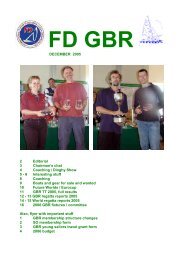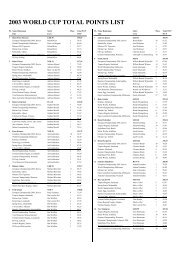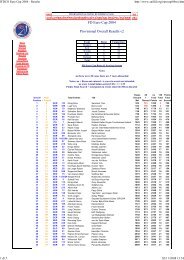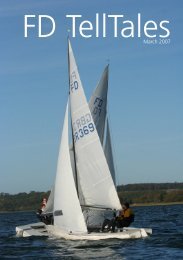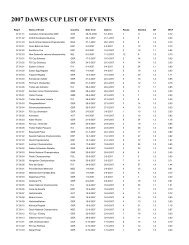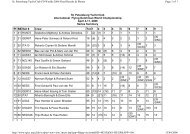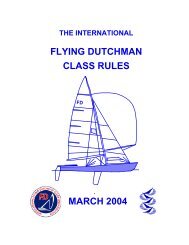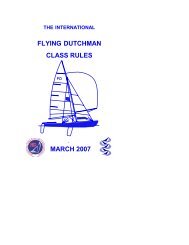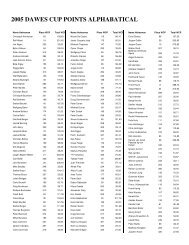MARCH 2010 - International Flying Dutchman Class
MARCH 2010 - International Flying Dutchman Class
MARCH 2010 - International Flying Dutchman Class
You also want an ePaper? Increase the reach of your titles
YUMPU automatically turns print PDFs into web optimized ePapers that Google loves.
INTERNATIONAL FLYING DUTCHMAN CLASS RULES <strong>2010</strong> 10<br />
33. Deck<br />
The deck shall not be higher than 10 mm above the deck line and shall be below the<br />
deck line at the mast partners. The deck line is the imaginary line between the top of<br />
the transom at the centreline and the highest point of the stem (excluding stem<br />
fittings).<br />
Instruction: Erect a taut line 150 mm above both the stem and the top of the<br />
transom, i.e. parallel to the deck line. The mast partners must be at least 150 mm<br />
below this line and the rest of the deck at least 140 mm below this line.<br />
34. The depth of section 9 must be 609 mm plus/minus 6 mm.<br />
Instruction: This is checked by applying the station 9 template and measuring the<br />
distance between the tie bar and the line used for checking the height of the deck (to<br />
be between 90 and 102 mm). (See the diagram on the Measurement Plan.)<br />
35. Cockpit<br />
The area of the hull, including spinnaker holes, not covered by fixed decking must<br />
be between a minimum of 1.5 m 2 and a maximum of 4.2 m 2 . Fixed decking is<br />
decking which is screwed, nailed, glued or moulded-in with the hull, which must not<br />
be removable during the race and which lies above or at the same level as the sheer<br />
height.<br />
Instruction: To find the limits of the cockpit area, a straight edge shall be laid across<br />
the cockpit. Measure the distance between the straight-edge and the sheer. The limit<br />
of the cockpit is where the inboard side of the side deck is at the same distance from<br />
the straight-edge as the sheer. It may be necessary to use Simpson's rule to<br />
determine the area. (See Measurement Plan).<br />
36. Rubbing Strakes<br />
AII hulls must be fitted with rubbing strakes (sheer guards) along the full length of<br />
the hull, which must nowhere measure horizontally more than a maximum of 50 mm<br />
or less than a minimum of 5 mm and vertically more than a maximum of 35 mm or<br />
less than a minimum of 10 mm. The rubbing strake is to be placed along the<br />
topsides at the gunwale. The width of rubbing strake across the transom and/or<br />
forward of the stem must not exceed a maximum of 12.5 mm.<br />
Instruction: A gunwale template is to be used to check maximum dimensions.<br />
Callipers are to be used to check minimum dimensions.<br />
37. The bearing point of the jib sheet on its fairlead must be forward of a plane<br />
perpendicular to the deckline and 2000 mm along the deckline from the transom. It<br />
must be impossible to fix the bearing point of the jib sheet on its fairlead, or to<br />
extend the operational clew cringle of the jib, aft of this plane. The bearing point of<br />
the jib sheet on its fairlead must not exceed a maximum of 60 mm above the upper<br />
side of the deck. The bearing point of the jib sheet is the after most point of the<br />
bottom of the groove of a sheave, or the forward side of the opening of a fairlead for<br />
the jib sheet. (See diagram)







